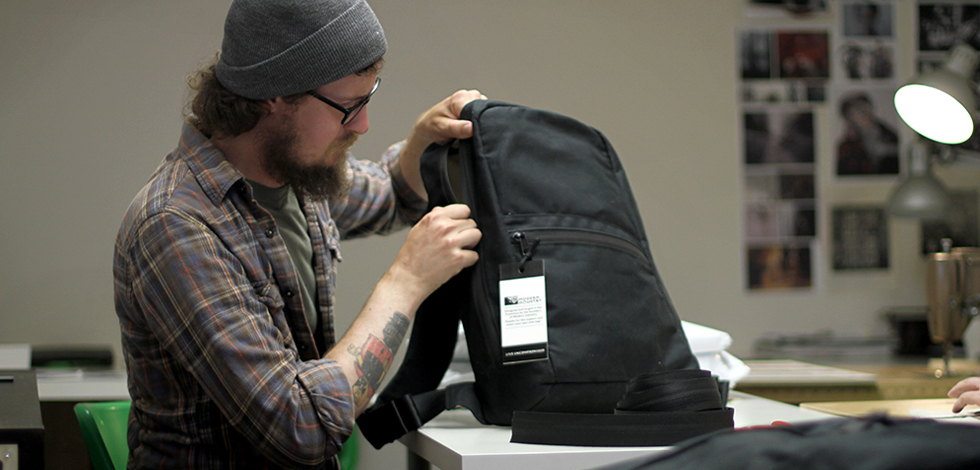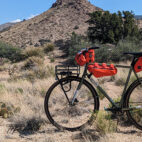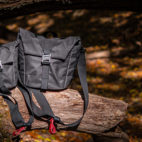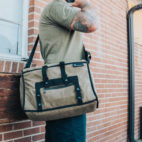Modern Industry :: Shop Visit
Here’s a name you should make sure stays permanently etched into your brain: Modern Industry. Founded by five friends in San Francisco, they are taking a fresh perspective to carry and pushing the industry forward in their own unique way. What follows is a summary of hours of talking to the guys to understand how the brand went from master’s thesis to Kickstarter success story to being highly commended in our Carryology Awards.
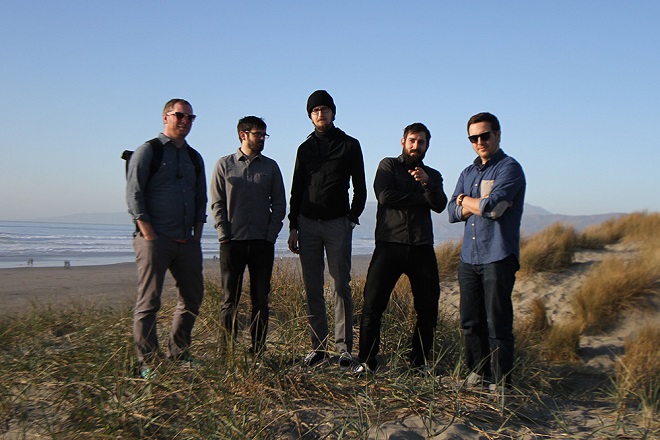
HQ
Nestled less than ten blocks away from Ocean Beach in the overcast Outer Sunset, you’ll find Modern Industry Headquarters in a junior one bedroom in the basement. You enter through the side door, go down a hallway filled with bikes (theirs and the upstairs neighbors) and enter the cramped yet cozy workspace. The first thing you notice are the skateboards stacked up (not an uncommon mode of transportation for the guys) with some bike lock cables sticking out.
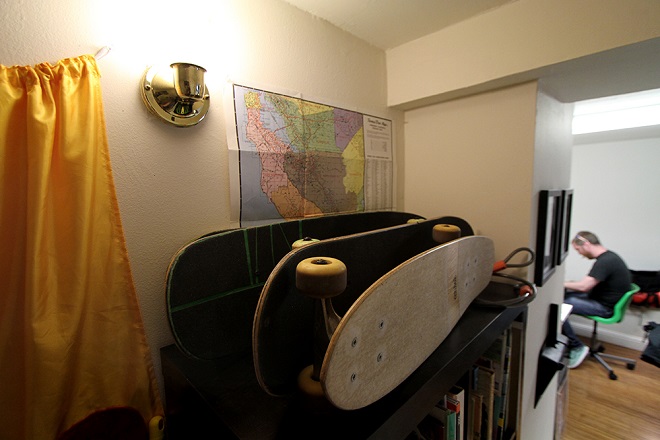
With space at such a premium, the walls are lined with product sketches, inspiration mood boards and whatever strikes that week’s fancy. The team has successfully managed to turn what is in essence a large studio into a literal production studio, which is no easy feat. There are three heavy-duty sewing machines which sew every stitch on a Modern Industry pack. That’s right, they cut, sew and make everything themselves.
As Taylor explained it, this flexibility has given them the ability to throw darts and not stress about over-committing themselves to one product or another. That means they can create a sample, take photos, throw it on the site and within hours know if the product is going to work. It’s a quick and efficient feedback loop that ultimately unites brand and customer. The added benefit is that they can scale production on demand should sales exceed planned demand on a given day or week. The same applies for special editions like a recent Giants Edition Drive which they did just for the heck of it.
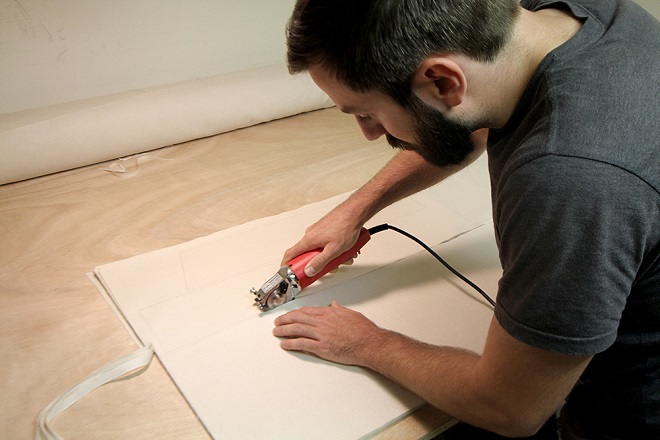
Over time, certain members of the team have shown themselves more adept at certain skills. Mike for example is a graphic designer and screen printer extraordinaire (although he can sew a mean stitch too). Having run a screen-printing shop before moving to San Francisco, Mike is the individual in charge of bringing the physical assets like hangtags, edition stamps and t-shirts to life. As he likes to say, some habits die hard.
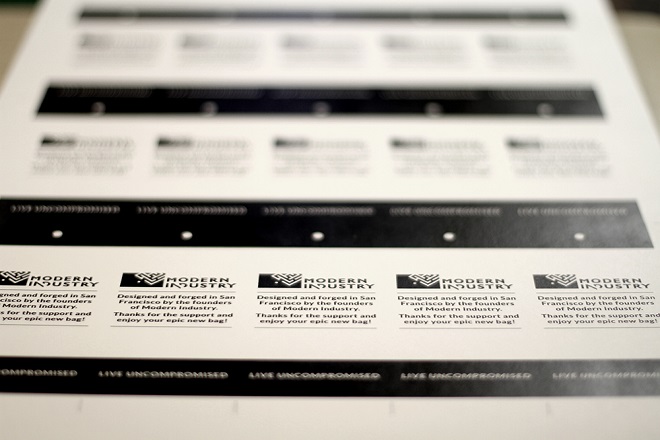
The side room has been converted into the fulfillment warehouse for all of the product including shirts and packs (although I would expect to see the new Apex merino hoodie make an appearance here soon).
It’s here that I get to talk about the guys themselves. We’ve told their story before but it’s amazing to watch how the brand has evolved in the last 1.5 years since that piece was published from an idea into a solid company. The experiment known as Modern Industry thus far has worked and there’s a quiet confidence Patrick, Lorris, Mike, Taylor and Tony have to solve whatever problem might crop up. As Taylor noted, they make mistakes and learn something new every day. Their happy-go-lucky attitudes mask a passion for craft and a desire to break the mold. The fact that after all this time they are still eager to get up, be surrounded by each other and push the envelope is refreshing. They say that their weekly pilgrimage to the local pizza joint every Friday for pies and beers helps with that too.
The Beginning
Two key events led to the direct creation of Modern Industry. The first was that three of the five founders, Patrick, Taylor and Tony, all shared your quintessential San Francisco apartment in the Lower Haight. The other was that Patrick was literally stapling fabric together at first and eventually sewing what became the Flux for his master’s thesis at art school.
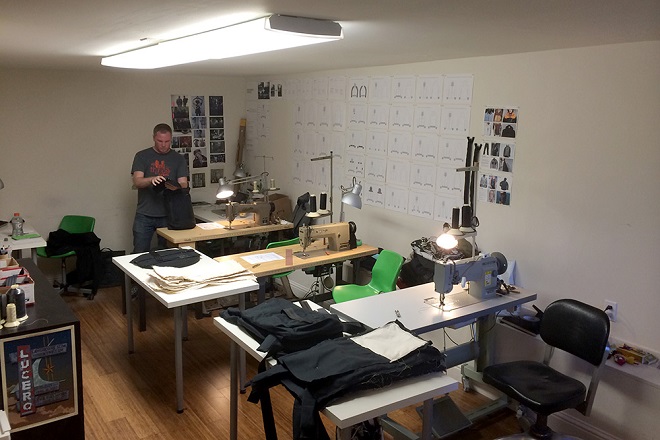
The initial vision for Modern Industry was to create products that allowed these self-described skaters and punk rockers to grow up without selling out. As Patrick says, “Bags are like billboards. They inform everyone around us of our values, beliefs and cultural affiliations.” At its core, Modern Industry was always meant to be a premium lifestyle brand with American-made products at reasonable prices. With that foundation laid out, they were able to design and build the Magnitude, Conduit and Wallet.
But before we jump ahead, there are two more key players (and friends) who were brought in. Mike with a graphic design and printing background, and Lorris, a fellow design student who had known each other since their first class on campus, Design Processes. Everyone hit it off with the product vision of designing for a culturally-minded individual who wants to be himself at home or at the office. The passion as they speak belies a simple fact: they are in this for the long haul and aren’t looking to cut corners.
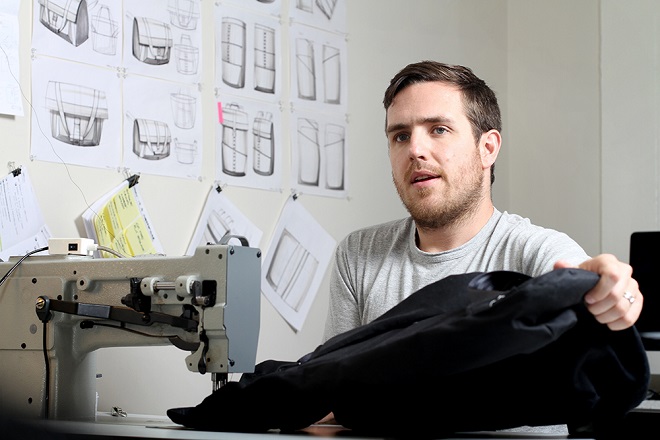
With so many people, it was clear that some loose structure had to be put in place. Patrick and Lorris head the design, Taylor oversees the marketing, Tony is the web designer/programmer and Mike is the graphic designer/printer.
Once a week they met in the apartment and simply built things. The first bags weren’t even sewn, they were literally stapled together in the apartment as proof of concepts. Over time, they learned how to sew, use proper construction techniques and effectively go from sketch to real product.

A Kickstarter Success Story
This is perhaps the part where some naïveté sets in. At the time, each co-founder put a little skin in the game with $1,000. At the time, it felt like a ton of money. Such is life when you’re bootstrapping your own company.
Back in 2012, there weren’t the platforms for crowdfunding that exist today. The choices were simple: Kickstarter or Indiegogo. In the end, the guys chose Kickstarter because of its reach and the community appeared to be kind to design-based ideas. Lorris was an early adopter of Kickstarter which also helped the decision-making process.
There was however one significant problem: the line they planned to introduce, a series of modular packs, needed to be completely redesigned to get funded. They talked with as many companies as they could and sought advice from luminaries like Mark Dwight of Rickshaw Bagworks. His advice helped streamline the bag concepts by the KISS method (keep it simple stupid). The added byproduct would be a reduction in the time and complexity of the manufacturing process.
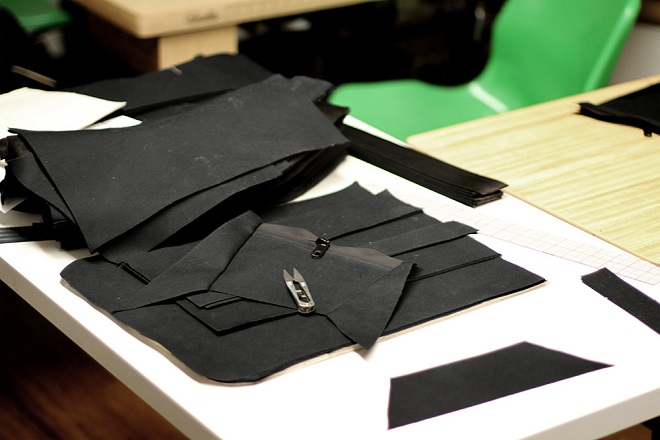
Lessons Learned
233 backers and $38K later, the campaign was a resounding success. Leading up to the launch, they aimed to build early awareness across the social channels like Facebook, Twitter and Instagram. They targeted niche subcultures that represented them like skaters and punks, who’d grown up. They even went so far as to send stickers and shirts to friends to help spread the word. They talked to anyone who was willing to listen. Fun fact: Carryology was the first interview they did!
That said, the month-long campaign wasn’t as smooth as future ones would be. To start, they launched it on December 12th, during the holiday season when people spend the week from Christmas to New Year’s largely away from the computer. Just like the product had to be streamlined, so too did the way they tell their story and communicate what’s important from a brand perspective. This has been a key reason why they continue to refine their site and overall presence online.
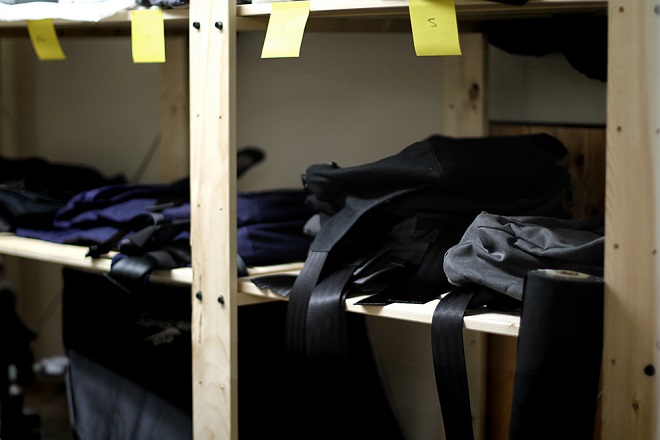
The making of their first three products (two bags and a wallet) was a trial by fire – it also forever reshaped the way the company thinks and operates. To start, they hit serious delays in manufacturing that almost cost them the business. With production, you start off as low man on the totem pole and they constantly found themselves stuck at the starting line, with the factory placing orders from previous customers ahead of theirs. A three-month cushion turned into a six-month delay in production with quality control issues to boot.
This was the moment that changed everything. They were small and too far away from the factory to change the situation. So they decided to make it all themselves and bring production in-house. This meant they were suddenly able to control the entire process and design new products with samples sewn in-house. Suddenly a process that took months of back and forth was brought down to weeks and eventually days.
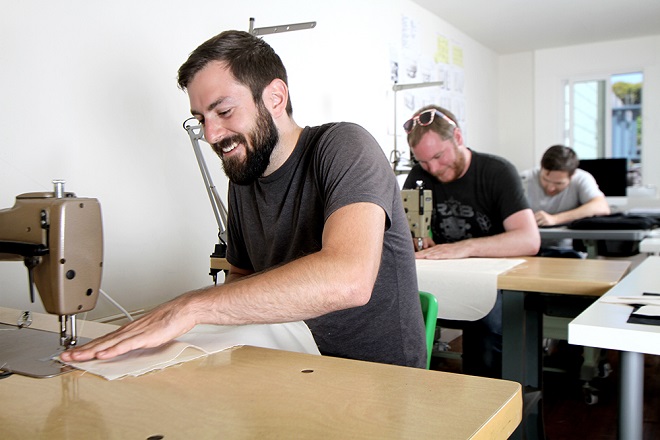
The New and Improved Modern Industry
There’s a passion in the way everyone speaks of the brand, what they are doing and where they plan to go that’s infectious. What started off as two bags (the Conduit and Magnitude) and a wallet has evolved into regular market tests to see what their fans think. That’s the benefit of making everything yourself – you can design something and put it on the site within a few days. If it sells, great! They fulfill the orders on demand as they continue to flush out new ideas.
Right now the line is driven by their rolltop bags, the Drive and Redux with limited runs of the Axial messenger bag and Faraday Tote. I was given a sneak peek at their first upcoming zip pack (name TBD) that’s distinctly Modern Industry. It’s nearly a full clamshell design that’s streamlined, efficient and clearly built to last.
Since Patrick and the crew have always viewed the company as a lifestyle brand, they are slowly moving into other categories as well, namely apparel. They’re developing the line based on their own personal interests and their second Kickstarter campaign smashed its funding goal in July for the Apex hoodie, made of a beautifully soft merino wool and sewn locally here in San Francisco. Expect these guys to grow into more categories as time goes on.
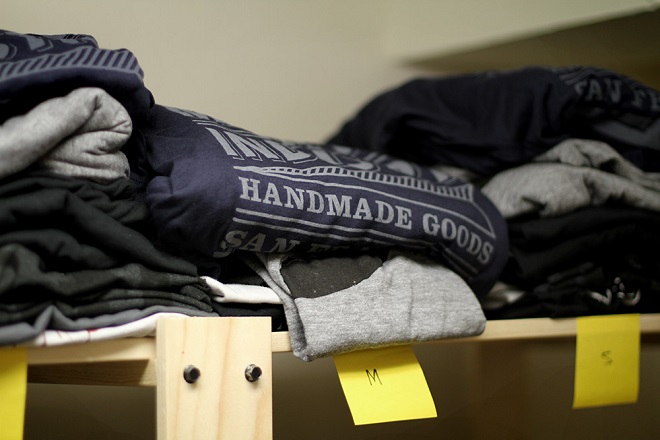
The Future
To be blunt, the future is bright for these guys. They are blazing a brand new trail in carry and the results show for themselves. They’ve tripled in volume over the last seven months (when they first sold their own product after Kickstarter). Not only that, but there’s even a humble brag of next to no returns. They must be doing something right!
When asked what advice they have for future designers, it was simple. JUST DO IT! (Sorry Nike…) Don’t worry about what you do or don’t know. You’ll figure it out over time and in the end the blood, sweat and tears will pay off. Just don’t quit your day job yet.





 Carry Awards
Carry Awards Insights
Insights Liking
Liking Projects
Projects Interviews
Interviews
